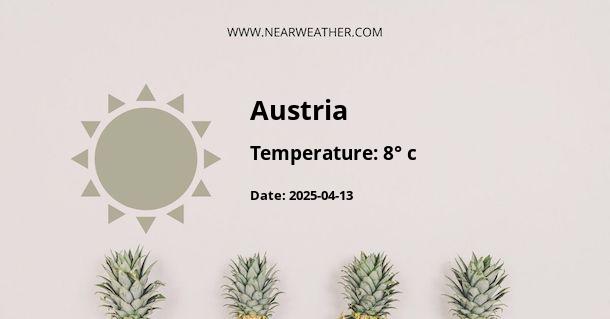Climate and Weather in the Republic of Austria
Austria, officially known as the Republic of Austria, is a landlocked country located in Central Europe. It is surrounded by eight countries, including Germany, Czech Republic, Slovakia, Hungary, Slovenia, Italy, Switzerland, and Liechtenstein. The country is known for its stunning alpine landscapes, historical cities, and rich cultural heritage. When it comes to climate and weather, Austria experiences a diverse range of conditions throughout the year.
Seasons in Austria
Austria has four distinct seasons: spring, summer, autumn, and winter. Each season brings its own unique characteristics and weather patterns.
Spring (March to May)
Spring in Austria is a beautiful time when nature comes back to life after the cold winter months. The temperatures start to rise, and the landscapes are adorned with colorful flowers and blossoming trees. However, spring can be quite unpredictable, with changing weather conditions. It can be sunny and warm one day, and rainy and cool the next. Average temperatures during spring range from 5°C (41°F) to 15°C (59°F).
Summer (June to August)
Summer in Austria is generally warm and pleasant, with plenty of sunshine. The temperatures can vary depending on the region, but in general, they range from 20°C (68°F) to 30°C (86°F). The mountainous regions tend to be cooler, while the lowlands and cities can experience higher temperatures. It is a popular time for outdoor activities, such as hiking, biking, and swimming in the many lakes and rivers across the country.
Autumn (September to November)
Autumn in Austria is a season of stunning colors as the leaves change from green to various shades of red, orange, and yellow. The temperatures start to cool down gradually, and the weather becomes more unpredictable. Rain showers are common during this time, but there are also many sunny days. Average temperatures range from 5°C (41°F) to 15°C (59°F) in autumn.
Winter (December to February)
Winter in Austria is synonymous with snow-covered landscapes and a magical atmosphere. The country is famous for its ski resorts, attracting winter sports enthusiasts from around the world. The temperatures can drop below freezing, especially in the alpine regions, with average temperatures ranging from -5°C (23°F) to 5°C (41°F). The amount of snowfall varies depending on the location, with higher amounts in the mountainous areas.
Regional Climate Variations
Austria's climate is influenced by its diverse topography, with the Alps covering a significant portion of the country. This results in regional climate variations across different parts of Austria.
Alpine Region
The alpine region, located in the western and southwestern parts of Austria, experiences colder temperatures and higher precipitation compared to other regions. The winters are longer and colder, with heavy snowfall, making it an ideal destination for winter sports. Summers in the alpine region are cooler and more refreshing, providing a pleasant escape from the heat.
Eastern Lowlands
The eastern lowlands, including Vienna, have a continental climate with less precipitation and milder winters compared to the alpine region. Summers in this region can be hot, with temperatures occasionally reaching over 30°C (86°F). The proximity to the Danube River also influences the climate in this area.
Central Region
The central region of Austria, including cities like Salzburg and Graz, experiences a mix of alpine and continental climates. The temperatures are milder compared to the alpine region, but winters can still be cold with moderate snowfall. Summers are generally warm and pleasant.
Precipitation and Sunshine
Austria receives a moderate amount of precipitation throughout the year, with regional variations. The alpine region tends to have higher precipitation due to orographic effects, where moist air rises and cools, leading to increased rainfall or snowfall.
The annual average precipitation in Austria ranges from 700mm (27.6 inches) in the lowlands to over 2000mm (78.7 inches) in the alpine regions. The wettest months are usually July and August, while the driest months are December and January.
When it comes to sunshine, Austria enjoys a good amount of sunshine hours each year. The average annual sunshine ranges from 1600 to 2000 hours, with the sunniest months being July and August.
Notable Weather Events
Austria, like many other countries, has experienced notable weather events throughout its history. These events have had significant impacts on the country and its people.
In recent years, Austria has faced extreme weather events such as heavy rainfall leading to flooding, especially in the alpine regions. These floods have caused damage to infrastructure, homes, and agriculture.
Additionally, the alpine regions are prone to avalanches during the winter months. Authorities take necessary precautions and implement safety measures to minimize the risks associated with avalanches.
Conclusion
Austria experiences a diverse climate and weather patterns throughout the year, offering something for everyone. From the snowy winter wonderland in the Alps to the warm and sunny summers in the lowlands, Austria provides a variety of experiences for both nature lovers and outdoor enthusiasts. It is important to keep in mind the regional variations and be prepared for changing weather conditions when visiting Austria.
A - Austria's Latitude is 47.333328 & Longitude is 13.333330.
A - Weather in Austria is 8° today.
A - Climate Conditions in Austria shows broken clouds today.
A - Humidity in Austria is 78% today.
A - Wind speed in Austria is 11.16 km/h, flowing at 164° wind direction. today.
